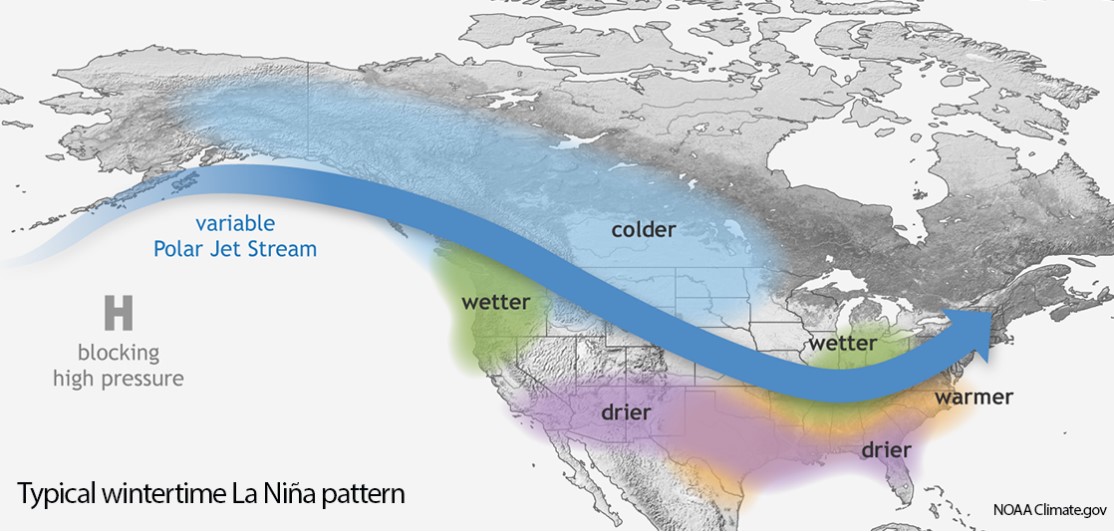National Oceanic and Atmospheric Administration's (NOAA) winter forecast for the U.S. favors warmer, drier conditions across the southern tier of the U.S., and cooler, wetter conditions in the north.
Scientists say there is a 75% chance that La Niña will be in place from December 2020 through February 2021.
During the winter, that means above-average precipitation and colder-than-average temperatures along the northern tier of the U.S.

While the southern states may not have as many worries about intense winter storms affecting their facilities, northern states should take extra precautions. And both should review their severe weather and emergency preparedness programs for the winter season.
Note: during COVID-19, many facilities were closed, and some are still not fully open to all employees. This makes it more important to go through the steps to winterize your facility.
Check Your Roof and External Physical Structure
If you have an accessible flat roof, go onto it and do a thorough site inspection. Make sure to remove any debris that is on the roof and clear all drains of obstructions.
First, walk the outer perimeter and then work your way inside. You’ll want to check that there aren’t any weak spots (too much give beneath the feet), flashing is secure and unbent, and that the roofing material shows no gapping, tears, bending, or damage.
If your roof is pitched, you may want to call an expert to walk the inclined perimeter of the roof and check the shingles for damage. You’ll want to verify gutters are clear of debris and that they are functioning properly.
Then move to your external structure. Check windows and doorways for gapping in the caulk, pulling from the facility, or damage. Run your hands around the casing to feel for moisture or airflow from inside to outside, and vice versa.
Visually check for any vines, mold, or other growth that needs removal. Additionally, double-check that all locking mechanisms are functioning and that security systems are operating correctly and are up to date.
Test HVAC, Backup Generator, and Emergency Lighting Systems
There are two systems in your facility that tend to be particularly prone to unexpected issues, especially when you need them most: your HVAC and your lighting.
When you turn on your furnace, even though it’s been sitting idle for the last 6 months or more, you expect it to start right up, kick in and make the facility warm and toasty. Increasing your level of utilization so drastically can cause building systems to malfunction, especially if they haven’t been maintained in the interim.
While you should already have a preventive maintenance plan in place, make sure you pay special attention to your HVAC, ventilation, backup units, and lighting systems.
Complete a thorough inspection of all the components before the weather gets too chilly so you have time to update or repair units, and clean, maintain, or replace parts. You may want to contact a professional.
Ventilation systems should be cleaned and checked to make sure they are properly working. The first time the heating unit comes on, it will stir up any dust or buildup that has settled inside the vents. That can produce a burning smell, which isn’t pleasant, or in some situations, it can ignite and catch fire.
Check your emergency lighting, run your backup generator, and make sure you have fresh fuel onsite.
It’s smart to spend time and money now rather than incur the additional cost of emergency fixes in the dead of winter.
Note: if your building has unoccupied sections, continue to run your heating unit through the winter to keep internal pipes above freezing temperatures. You can readjust your setpoints to meet the minimum heating requirements and reduce your consumption.
Be Prepared to Cover Exposed Pipes, Plants, and Foliage
The probability that a pipe will burst due to cold weather is dependent upon numerous factors such as material, condition, and location. However, when temperatures drop below 32 degrees, frozen lines, and pipe bursts become more likely.
Especially now that buildings may have fewer occupants, there will be fewer sinks running, not as many toilets flushing, and less water movement through the pipes. That movement helps keep waterlines from freezing.
Make sure you have the materials on hand to cover external pipes and keep them safe. Your inventory should also include plant covering to protect the facility’s foliage during deep freezes.
Note: if your building has unoccupied sections, make sure you allow sinks to drip and flush toilets around the building to continue water flow through the pipes on frigid days.
Please Be Aware - Not Winterizing Your Business Correctly May Risk the Safety and Security of Your Facility.
When a building is not properly winterized, problems can occur such as physical damage to employees and customers, loss of power and heat, and damage to the overall integrity of your building.
Flagship Facility Services is ready to help you take care of all your winterizing needs so you can focus on your core business. Flagship provides facilities services that will make sure your facility remains safe and well-maintained.
Flagship's customizable approach to your facility's needs will help you protect employees and your assets now and into the future.
Email a facilities expert today and get the help you need to keep your facility healthy and safe.





Leave a Comment